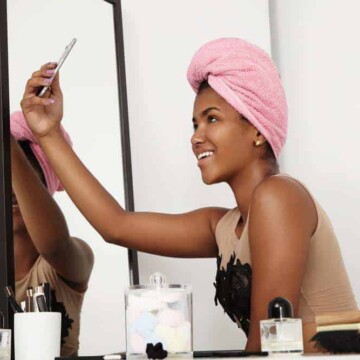
You’ve had fun with your hair color experiments, and now it’s time to get back to basics – "basics," meaning your natural hair color. But how do you go about it?
There are several ways, and we'll teach you how to go back to your natural hair color in this article. By the end, you’ll be able to choose the right option for you with confidence.
Table of Contents
How to Go Back to Your Natural Hair Color
Returning to your natural hair color is a journey filled with twists and turns, requiring patience and understanding of your hair's unique traits. Whether it's about embracing the aging process, reconnecting with your roots, or simply yearning for a change, this journey is a testament to personal transformation.
In the next section, we'll guide you through the process, providing invaluable tips and techniques to help you embrace your natural hair color gracefully, ensuring the health and vibrancy of your curls.
Dye Over It
The first way to go back to your natural hair color is to dye over your existing hair color. This may be the best course of action for you if know your way around hair dyes and developer. If not, you’ll definitely want to leave this to the professionals.
The way you’ll use dye depends on how light your hair is now and what your natural hair shade is. But we’ll simplify things by telling you how to go lighter and how to go darker.

Dye Your Hair Lighter
To go lighter, you can use a permanent box dye or professional color. Here’s how to make it happen:
- Strip the dye from your hair. Since you’re going lighter, you need to give your hair a clean slate, otherwise, the existing dye may affect the final results. To do so, you’ll choose a color remover, like Color Oops, to strip the existing color from your hair. If your hair was previously bleached or color-treated with permanent dye or bleach, you may still need to dye it after removing the existing hair color from it. To strip dye from your hair, you’ll follow the instructions on your color removal product to the letter. The instructions will be different for every product.
- If you don’t like the idea of using a color remover or any other chemical, go for a clarifying shampoo. Though it won’t take all of the color off at once, it will strip some of the color away each time you shampoo. Opt for this method if you don’t mind fading your color gradually.
- Get your hands on a hair dye that’s identical to your natural hair color. You may need to shop around in-person and/or online to find the right shade. If you’re not sure what your natural hair shade is, go back and look at photos of you before you dyed your hair. Use them as a reference. Since you’re going lighter, you’ll have to use a dye kit that comes with developer, or buy the dye and developer separately and mix them together later. The developer is what will open up your hair cuticles and facilitate the hair lightening process.
- Pick up your other supplies. In addition to the hair dye, you may need the following items. If you’re going with a box dye, check to ensure that these items aren’t already included in the package:
- Developer
- Vaseline
- Comb
- Plastic processing cap
- Shampoo
- Conditioner
- Mixing Bowl and tinting brush (not necessary for box dye)
- Wash your hair if needed. It’s okay if your hair is a little on the dirty side, but it shouldn’t be filthy or full of product buildup. If your hair is caked in buildup and excess debris, the color might not take evenly. So, if your hair is visibly dirty, you’ll want to wash it with clarifying shampoo and then wait 48 hours to dye it. Don’t condition afterwards.
- Prepare your space. Before you get started on dye day, take the following steps to ensure that everything goes off without a hitch:
- Put towels down on the floor and on the counter to protect the surfaces from any spills.
- Open up a window and/or use a fan for extra ventilation. Dyeing your hair in a stuffy room without adequate ventilation could result in you breathing in dangerous fumes.
- Put on a shirt you don’t care much about. If that’s not possible, drape a towel over your shoulders. Doing so will protect your clothing from dye splatter. The towel may also come in handy should any dye drip down onto your face or neck.
- Part your dry hair into sections. Gently part your hair into sections using a wide tooth comb or your fingers. The parts don’t have to be perfect. Secure each of the sections with a scrunchie or large hair clip.
- Protect your hairline. Put some Vaseline along your hairline in the front as well as in the back. And don’t forget to apply it to the top portion of your ears. You’ll do this to protect your skin from staining.
- Mix up your dye according to the instructions on the packaging. If you have a box dye, you’ll pour the dye into the developer bottle and shake vigorously. If you’re working with a professional dye, you’ll pour two parts developer into a bowl and one part dye and mix thoroughly with your tinting brush. In situations where the instructions on the packaging differ from our suggestions, go with the instructions on your specific dye and developer.
- Apply the dye to your hair. Begin applying the dye to your hair in sections, avoiding the roots initially. Go back after you’ve applied the dye to the mid-lengths and ends and apply it to the roots. Leave the dye to process for as long as it says on the packaging. Usually, it’ll be around 20 to 30 minutes but may vary.
- Rinse the dye out and shampoo. After the dye is done processing, rinse it out until the water runs clear. Then, wash your hair with a moisturizing shampoo the same way you would normally.
- Condition. Condition your hair to replenish some of the moisture removed during the color stripping and dyeing processes. Your hair will need some TLC. You can also use a deep conditioner if you’d like.
- Proceed with styling.

Dye Your Hair Darker
If your natural hair is darker than your current hair color, you likely won’t need to do a color removal treatment to go back to your natural color. Instead, you can color your hair right over your existing hair dye.
Semi-Permanent Dye
Semi-permanent dyes are among the easiest to work with because they don’t require you to do any mixing, and they aren’t as harsh on the hair as a demi-permanent dye, permanent dye, or bleach.
Here’s what you need to do to go darker with semi-permanent dye:
- Choose your semi-permanent dye. Semi-permanent dyes come in virtually every color you can imagine. Chances are you can easily find one in your natural hair color. Just shop around a bit to find your perfect match. Don’t forget to consider the undertone of a given color (match it to yours).
- Get the rest of your supplies. For semi-permanent dye jobs, you’ll need the following supplies:
- Vaseline
- Comb
- Plastic processing cap
- Conditioner
- Mixing bowl (not necessary for box dye)
- Tinting brush
- Prepare and protect your space and clothing. Put some towels on the floor and counters to protect your floor and vanity. And throw on some clothes that you don’t care much about. Open up some windows for ventilation.
- Wash your hair 24 to 48 hours before dyeing your hair. When using semi-permanent dye, your hair needs to be very clean – free of scalp oils, products, and everything else. Why? Because semi-permanent dye doesn’t penetrate the hair shaft – it stains the outer layer of the hair. So, there should be nothing on the hair that could prevent the dye from reaching the hair shaft. Wash your hair with a clarifying shampoo once or twice 24 to 48 hours before dyeing to ensure it's clean and ready for dyeing.
- Part your hair for the dyeing process with a comb or your fingers. 4 sections are standard, but you can make more sections if your hair is really thick.
- Dispense your dye into a mixing bowl. Stir it a bit with your tinting brush to ensure it’s creamy, smooth, and ready for application.
- Apply the dye to your hair in sections, ensuring that every single strand is covered. Any strands that aren’t covered in dye won’t turn your desired color. You might need to go back later and redye your hair if this happens. So, be very generous with the dye.
- Wait for the amount of time indicated on the hair dye’s packaging. Some like to leave their semi-permanent dye on their hair for hours, but you don’t have to do that. Leave the dye on for around 30 to 45 minutes (or as long as the instructions say).
- Rinse the dye out until the water runs mostly clear. Ensure that the water isn’t hot, or else it could strip the dye out of your hair and leave you with a more faded look than you would’ve had otherwise.
- Condition your hair with a hydrating conditioner and proceed with your normal hair care and styling routines.

Demi-Permanent dye
Demi-permanent dyes aren't nearly as popular as semi-permanent or permanent dyes, but they'd work great for the purpose of darkening your dyed hair. What makes demi-permanent dye attractive is that it has more staying power than semi-permanent dye but isn't as hard on the hair as a permanent dye.
So, if you're looking for a longer-term solution and you want your natural hair color to stay around for a while, maybe demi-permanent dye is the best option for you.
To use demi-permanent dye, you'll gather your materials - most of the same ones that we mentioned under the semi-permanent dye section. However, you'll be using demi-permanent dye and 10-volume developer or lower.
Here's what you need to do in detail:
- Shampoo your hair with a clarifying shampoo 12 to 24 hours prior to using demi-permanent dye. Your hair should be clean before using it. Don't condition.
- On dye day, part your hair into 4 sections (gently) and secure each section with an elastic band or clip.
- Mix up your demi-permanent dye and developer according to the instructions on the packaging.
- Begin applying the dye to your mid-lengths and ends, and then go back and do your roots.
- Leave the dye on for however long the manufacturer instructs on the packaging.
- Rinse your hair and then wash it with a moisturizing shampoo and follow that up with a conditioner.
- Continue on with your hair care and styling routine.
Note: You can use a permanent hair dye if you're looking to cover grays. Use the instructions given earlier for that. The only difference is that you'll mix the dye and developer using a 1:1 ratio.

Cut the Color Out
If you really want your natural hair color back and don’t want to go through a color process, you don’t have to. You can just cut the colored parts away and wait for your natural hair to grow out.
This is a rather drastic way to get back to your natural hair color, so it’s not for everyone. But it’s an option nonetheless.
Just so you're prepared, hair grows about a half inch per month.
Note: If you'll be DIYing your cut, it's wise to ensure that you've got the right materials on hand. At a minimum, you should have a comb and some hair cutting shears.
These are the standard choice when cutting hair, and that's because they are much sharper than regular scissors (which are so dull that they can fray your strands and cause split ends). Hair cutting shears usually cost anywhere from $10 to $20, but they're well worth the price.

Grow the Color Out Gradually - Transition
Cutting the color out might be way too much to consider. If that's the case, maybe growing your color out gradually is a better idea for you. To grow your color out, you'll simply stop coloring your hair and allow your natural hair to grow in.
Some people like to highlight or balayage their hair to blur the line of demarcation between their natural and color-treated hair. You can do that too.
For instance, if you're transitioning from blonde to brown, you can get some highlights in a blonde/light brown color to ease the transition to your natural hair color.
Just know that highlights and balayage do come with some risks. Any time you color or bleach your hair, it can become damaged. The issue is that these chemical treatments forcibly open your hair cuticles to alter your hair color.
And your cuticles are never the same after that.
You could also experience severe dryness after a hair color treatment. So, ensure that your hair is in good condition before highlighting or balayage treatments. You don't want to have to cut off your color after damaging your hair.

Use Color Waxes and Sprays
Hair color waxes and sprays stain the outside of your hair to give off a specific color. And they do so on a temporary basis. If you want to get your natural hair color back, but only for up to a week or so, these waxes and sprays might be a better option than the ones we mentioned previously.
The way you'll use a given color wax or spray will depend on the brand. Be sure to read the application instructions, and be on the lookout for any warnings. Use the product exactly as designed.
Should You Reach Out to a Professional?
There are certainly times when you should reach out to a professional to go back to your natural hair color. For instance, if your natural hair color is a lot lighter than your current hair dye, you'll have to use a product with some degree of lightening power.
That's almost always associated with hair damage, and since there's an art and a science to hair dyeing, you could end up with results you didn't go for.
So, it all comes down to whether you're comfortable lightening your own hair. If not, you should definitely reach out to a colorist in your area for a consultation and color service. On the other hand, going darker is usually a lot easier than going lighter.
You won't be using high-lift color or bleach to achieve your color result, so you don't have to worry about overprocessing your hair. Many more people can successfully use this method to get their natural hair color back.
But if, at any time, you feel lost or unsure about what you're doing or how to get the results you're going for, it's always a good idea to at least talk to a professional.
Some stylists will offer advice via phone or a free consultation. You can use their knowledge to your advantage, even if you're not planning on having them do a color service for you.

Can I Get My Natural Hair Color Back with Vitamins?
Many on the internet have asked this question because of rumors that have gone around social media. No, vitamins will not change hair that's been chemically colored.
Also, if your hair is gray and you want it to go back to your old hair color, vitamins won't help. But if your hair color changes because of a vitamin deficiency or illness, B vitamins may be able to help you.
We urge you to contact a medical professional before trying any new supplements.
- How Long Does It Take for Roots to Grow Out
- Using Color Remover to Reveal Gray Hair
- Why Won’t My Hair Hold Color
So, there you have it - several ways to get your natural hair color back. We hope that one of the methods is helpful to you, and we wish you the best with your hair!




